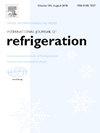低gwp制冷剂两相喷嘴性能的实验评估
IF 3.5
2区 工程技术
Q1 ENGINEERING, MECHANICAL
International Journal of Refrigeration-revue Internationale Du Froid
Pub Date : 2025-02-12
DOI:10.1016/j.ijrefrig.2025.02.008
引用次数: 0
摘要
两相喷射器的性能在很大程度上取决于动力喷嘴的效率,它控制着临界质量流量和整个系统的运行。然而,由于热力学和流动动力学的复杂相互作用,精确预测两相流条件下喷嘴的性能仍然具有挑战性。本研究通过评估CO2、R600a和R1234ze(E)三种制冷剂的动力喷嘴的性能系数来解决这一问题。除了喷射器应用之外,了解两相流动力学对于优化在类似条件下工作的其他关键部件(如控制阀和安全阀)至关重要。在多功能试验台上进行的实验表明,不同制冷剂的喷嘴性能存在显著差异。CO2的性能系数为0.85 ~ 1.35,R600a为0.90 ~ 1.15,R1234ze(E)为0.92 ~ 1.22。用于预测临界质量流量的Henry-Fauske模型显示,CO2的平均偏差为30%,而R600a(9%)和R1234ze(E)的偏差要低得多(4%)。研究结果强调了性能系数对制冷剂热力学性质的敏感性,其中CO2由于其较低的临界温度和较高的可压缩性而表现出最复杂的流动行为。该研究为两相流下的动力喷嘴性能提供了定量的见解,并验证了简化模型在预测临界流量方面的适用性。研究结果有助于优化喷射器和阀门设计,强调需要进一步验证额外的制冷剂,以提高模型的通用性。本文章由计算机程序翻译,如有差异,请以英文原文为准。
Experimental assessment of two-phase nozzle performance for low-GWP refrigerants
The performance of two-phase ejectors critically depends on the efficiency of motive nozzles, which govern the critical mass flow rate and overall system operation. However, accurately predicting nozzle performance under two-phase flow conditions remains challenging due to the complex interplay of thermodynamic and flow dynamics. This study addresses this issue by evaluating the performance coefficient of motive nozzles for three refrigerants: CO2, R600a, and R1234ze(E). Beyond ejector applications, understanding two-phase flow dynamics is essential for optimizing other key components, such as control valves and safety valves, which operate under similar conditions. Experiments conducted on a versatile test bench revealed significant differences in nozzle performance among the refrigerants. The performance coefficient ranged from 0.85 to 1.35 for CO2, 0.90 to 1.15 for R600a, and 0.92 to 1.22 for R1234ze(E). The Henry-Fauske model, used to predict critical mass flow, demonstrated an average deviation of 30 % for CO2, while deviations were much lower for R600a (9 %) and R1234ze(E) (4 %). The results highlight the sensitivity of the performance coefficient to the refrigerant thermodynamic properties, with CO2 exhibiting the most complex flow behavior due to its lower critical temperature and higher compressibility. This study provides quantitative insights into the performance of motive nozzles under two-phase flow and validates the applicability of simplified models for predicting critical flow rates. The findings contribute to optimizing ejector and valve design, emphasizing the need for further validation with additional refrigerants to enhance model universality.
求助全文
通过发布文献求助,成功后即可免费获取论文全文。
去求助
来源期刊
CiteScore
7.30
自引率
12.80%
发文量
363
审稿时长
3.7 months
期刊介绍:
The International Journal of Refrigeration is published for the International Institute of Refrigeration (IIR) by Elsevier. It is essential reading for all those wishing to keep abreast of research and industrial news in refrigeration, air conditioning and associated fields. This is particularly important in these times of rapid introduction of alternative refrigerants and the emergence of new technology. The journal has published special issues on alternative refrigerants and novel topics in the field of boiling, condensation, heat pumps, food refrigeration, carbon dioxide, ammonia, hydrocarbons, magnetic refrigeration at room temperature, sorptive cooling, phase change materials and slurries, ejector technology, compressors, and solar cooling.
As well as original research papers the International Journal of Refrigeration also includes review articles, papers presented at IIR conferences, short reports and letters describing preliminary results and experimental details, and letters to the Editor on recent areas of discussion and controversy. Other features include forthcoming events, conference reports and book reviews.
Papers are published in either English or French with the IIR news section in both languages.

 求助内容:
求助内容: 应助结果提醒方式:
应助结果提醒方式:


